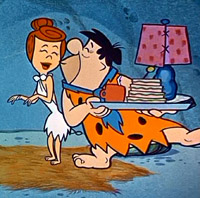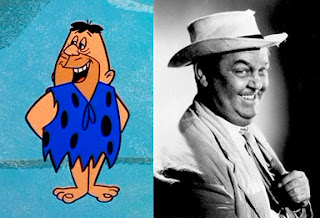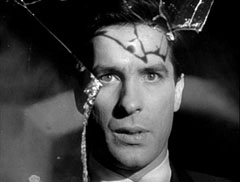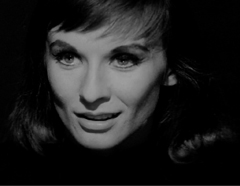 The Flintstones has the distinction of being the first animated situation comedy to air in prime time, shown at 8:30 ET on ABC starting September 30, 1960, an idea considered so novel that Dwight Whitney in the December 31 edition of TV Guide claimed that the show was the exception to the "year's dearth of new entertainment series with anything resembling a new idea." But the show owed a great deal to Jackie Gleason and The Honeymooners, as readily admitted by co-producer William Hanna and just as eagerly denied by his partner Joseph Barbera. Gleason himself noted in a 1986 interview that at the time he had thought about suing Hanna-Barbera for copyright infringement and his lawyers had told him he could probably have the show pulled off the air, but the move would make him very unpopular and he decided not to proceed.
The Flintstones has the distinction of being the first animated situation comedy to air in prime time, shown at 8:30 ET on ABC starting September 30, 1960, an idea considered so novel that Dwight Whitney in the December 31 edition of TV Guide claimed that the show was the exception to the "year's dearth of new entertainment series with anything resembling a new idea." But the show owed a great deal to Jackie Gleason and The Honeymooners, as readily admitted by co-producer William Hanna and just as eagerly denied by his partner Joseph Barbera. Gleason himself noted in a 1986 interview that at the time he had thought about suing Hanna-Barbera for copyright infringement and his lawyers had told him he could probably have the show pulled off the air, but the move would make him very unpopular and he decided not to proceed.
But while the characters Fred and Barney (and to a lesser degree Wilma and Betty) bear more than a passing resemblance to those on The Honeymooners, the show was quite original in its clever depiction of modern technology in stone-age terms. Everything from record players to garbage disposals are recreated using wood, stone, and animals. The irony in these deliberate anachronisms is that the conveniences of the dawning space age are shown as if they had been around for millenia, as if to say that the advances and progress of modern times were in fact reinventions of the wheel. The show also parodied contemporary show-biz personalities, with Cary Grant sound-a-like character Gary Granite in "The Monster of the Tar Pits" (November 4, 1960) and Wilma casually referring to Perry Masonry in another episode.
The humor obviously made the show a hit, ranking 18th overall in the Nielsen ratings for 1960-61, and leading to a 6-year run, a record not equaled by an animated series until The Simpsons decades later. Subsequent attempts by Hanna-Barbera to replicate this success with Top Cat in 1961 and The Jetsons in 1962 lasted only a single season each.
 What is most striking in viewing the 14 episodes from 1960 is how thoroughly unlikeable the character of Fred Flintstone is. He is almost always rude and mean to his friend Barney, who is almost always a devoted and true friend (with the possible exception of the few times that he tells Fred bluntly that he is fat). He treats Wilma like a slave, though this is probably typical for the era (the 1960's, that is). He has an over-inflated belief in his own importance and abilities. And he is not above cheating, lying, or causing physical harm to get what he wants. For example, in "The Flintstone Flyer" (September 30, 1960), he attempts to usurp Barney's invention of a flying machine by merely stating that he will be the company president when he made no contribution to the invention nor did Barney ask his help in selling it. In "Hollyrock Here I Come" (December 2, 1960), he tries to use a two-headed coin to cheat Barney and Betty out of a trip to Hollyrock, though Barney is keen to his trickery. The show even acknowledges Fred's boorish character in "The Split Personality" (October 28, 1960), in which Fred is hit on the head with a bottle and is instantly transformed into the perfect husband and the model of refinement as his alter-ego Frederick. To use a more modern comparison, Fred Flintstone is like Homer Simpson with a mean streak and without Homer's endearing cluelessness.
What is most striking in viewing the 14 episodes from 1960 is how thoroughly unlikeable the character of Fred Flintstone is. He is almost always rude and mean to his friend Barney, who is almost always a devoted and true friend (with the possible exception of the few times that he tells Fred bluntly that he is fat). He treats Wilma like a slave, though this is probably typical for the era (the 1960's, that is). He has an over-inflated belief in his own importance and abilities. And he is not above cheating, lying, or causing physical harm to get what he wants. For example, in "The Flintstone Flyer" (September 30, 1960), he attempts to usurp Barney's invention of a flying machine by merely stating that he will be the company president when he made no contribution to the invention nor did Barney ask his help in selling it. In "Hollyrock Here I Come" (December 2, 1960), he tries to use a two-headed coin to cheat Barney and Betty out of a trip to Hollyrock, though Barney is keen to his trickery. The show even acknowledges Fred's boorish character in "The Split Personality" (October 28, 1960), in which Fred is hit on the head with a bottle and is instantly transformed into the perfect husband and the model of refinement as his alter-ego Frederick. To use a more modern comparison, Fred Flintstone is like Homer Simpson with a mean streak and without Homer's endearing cluelessness.
When brainstorming the series, Hanna-Barbera tried other names, The Flagstones and the Gladstones, before settling on The Flintstones, and tried out the characters in other historical and cultural milieu before settling on the stone age as the ideal setting. The DVD release for the first season includes a short excerpt from The Flagstones using differently drawn characters and different voice actors than those in the final production. This pilot or concept short includes a sequence of scenes that would be included, redrawn and re-voiced, in the episode "The Swimming Pool," which was the second episode ever aired, though it was likely completed before the debut episode, "The Flintstone Flyer."
 The first season did not include the iconic theme song "The Flintstones" but was introduced with a generic instrumental titled "Rise and Shine," which sounds a lot like the theme song for The Bugs Bunny Show. However, the musical score for many episodes, composed by long-time Hanna-Barbera music director Hoyt Curtin, often contains the melody, subtly rendered, that would later become "The Flintstones" theme song. The opening sequence, accompanied by the "Rise and Shine" theme music, shows Fred driving home from work and parking the car in the garage, then going inside and turning on the TV, obviously the inspiration for the opening sequence of The Simpsons. Starting in Season 3 with the addition of "The Flintstones" theme song, this sequence was changed to show Fred, Wilma, Barney, and Betty going to a drive-in restaurant. Also in the Season 1 opening sequence, when Fred enters the house, Wilma is waiting for him with a plate stacked with food. He grabs the plate while walking past her on his way to the TV, then stops, returns to give her a kiss, before proceeding on to the TV. This little double-take is very reminiscent of the opening sequence for The Donna Reed Show in which Donna gives each family member a sack lunch on their way out the front door, with her husband Alex having to return to give her a peck on the cheek before leaving.
The first season did not include the iconic theme song "The Flintstones" but was introduced with a generic instrumental titled "Rise and Shine," which sounds a lot like the theme song for The Bugs Bunny Show. However, the musical score for many episodes, composed by long-time Hanna-Barbera music director Hoyt Curtin, often contains the melody, subtly rendered, that would later become "The Flintstones" theme song. The opening sequence, accompanied by the "Rise and Shine" theme music, shows Fred driving home from work and parking the car in the garage, then going inside and turning on the TV, obviously the inspiration for the opening sequence of The Simpsons. Starting in Season 3 with the addition of "The Flintstones" theme song, this sequence was changed to show Fred, Wilma, Barney, and Betty going to a drive-in restaurant. Also in the Season 1 opening sequence, when Fred enters the house, Wilma is waiting for him with a plate stacked with food. He grabs the plate while walking past her on his way to the TV, then stops, returns to give her a kiss, before proceeding on to the TV. This little double-take is very reminiscent of the opening sequence for The Donna Reed Show in which Donna gives each family member a sack lunch on their way out the front door, with her husband Alex having to return to give her a peck on the cheek before leaving.
All six seasons have been released on DVD, as well as a complete series package that includes them all.
The Actors
 Alan Reed
Alan Reed
Born in New York, Reed studied journalism at Columbia University, then found success as a radio announcer and voice actor as well as appearing on Broadway. He began appearing in films in the 40s and had starring roles in The Postman Always Rings Twice, Viva Zapata! (in which he played Pancho Villa), and I, the Jury. In the 50s he also had recurring TV roles as Finnegan on Duffy's Tavern and J.B. Hafter on Mr. Adams and Eve. He also provided the voice for the character Boris in Disney's Lady and the Tramp in 1955. His casting as the voice of Fred Flintstone was no doubt owed to his vocal similarity to Jackie Gleason and his physical resemblance to Flintstone. He came up with the phrase "Yabba Dabba Do," which Fred first utters in the very first episode, "The Flintstone Flyer," but uses sparingly thereafter in the first season. During The Flintstones run and continuing in the later 60s he made occasional appearances on other shows like Batman, Dr. Kildare, and The Addams Family. He died June 14, 1977 at the age of 69.
Jean Van Der Pyl
 Born in Philadelphia to Dutch immigrants, Van der Pyl got her start in voice acting with Hanna-Barbera on The Huckleberry Hound Show in 1959 and appeared in two episodes of Quick Draw McGraw before landing the role of Wilma Flintstone. She had a long, prolific tenure with Hanna-Barbera, providing the voice for Pebbles on The Flintstones, Rosie the Robot on The Jetsons, Ma Rugg and Floral Rugg on the Atom Ant and Secret Squirrel shows as well as The Banana Splits Adventure Hour, and Marge Huddles on Where's Huddles?, amongst many others. She also made on-camera appearances on Leave It to Beaver, Petticoat Junction, and The Donna Reed Show. She died April 10, 1999 at age 79.
Born in Philadelphia to Dutch immigrants, Van der Pyl got her start in voice acting with Hanna-Barbera on The Huckleberry Hound Show in 1959 and appeared in two episodes of Quick Draw McGraw before landing the role of Wilma Flintstone. She had a long, prolific tenure with Hanna-Barbera, providing the voice for Pebbles on The Flintstones, Rosie the Robot on The Jetsons, Ma Rugg and Floral Rugg on the Atom Ant and Secret Squirrel shows as well as The Banana Splits Adventure Hour, and Marge Huddles on Where's Huddles?, amongst many others. She also made on-camera appearances on Leave It to Beaver, Petticoat Junction, and The Donna Reed Show. She died April 10, 1999 at age 79.Mel Blanc
The most famous and prolific cartoon voice actor ever, Portland, Oregon native Blanc not only provided the voice for Barney Rubble but also Bugs Bunny, Daffy Duck, Sylvester and Tweety, Porky Pig, Speedy Gonzales, Yosemite Sam, and many more. He was in a near-fatal car accident in January 1961, which put him in a coma. Doctors were able to lead him out of the coma by getting him to respond as some of his cartoon characters, such as Bugs Bunny. When he regained consciousness the production team recorded several episodes of The Flintstones from his hospital room and at his home after he was discharged. However, he had to be replaced by Daws Butler for five episodes in Season 2. He also developed the voice and laugh of Woody Woodpecker, though he appeared in only the first four Woodpecker films before being signed to an exclusive contract by Looney Tunes' Leon Schlesinger. He later sued Woodpecker creator Walter Lantz for continuing to use his laugh in later films without compensation. His rare on-screen appearances included numerous characters on The Jack Benny Show and as Dr. Sheldrake in Billy Wilder's 1964 feature Kiss Me, Stupid. He also provided the voice for various birds on non-animated TV shows, including The Raven on The Munsters and various parrots and mynah birds on Perry Mason, Burke's Law, and Gilligan's Island. He died July 10, 1989 at age 81. His tombstone reads, "That's all, folks!"
Bea Benaderet
 Born in New York and raised in San Francisco, Benaderet began doing voice work on radio at age 12 and was given a regular role on Campbell's Playhouse by Orson Welles. She continued doing radio voice work as well as a number of film shorts, including Looney Tunes cartoons, throughout the 40s and into the 50s. In 1950, she transitioned to television when she was cast as Blanche Morton on The George Burns and Gracie Allen Show. She was offered the role of Ethel Mertz on I Love Lucy but had to turn it down because of her contract with the Burns and Allen show. She provided the voice for Mother Magoo on the Mister Magoo TV show before being cast as the voice of Betty Rubble on The Flintstones, which she continued for the first four seasons, thereafter replaced by Gerry Johnson. After appearing in 290 episodes of The George Burns and Gracie Allen Show, she appeared as the character Wilma on Peter Loves Mary in 1960-61 and Cousin Pearl Bodine on The Beverly Hillbillies before appearing as Kate Bradley on Petticoat Junction and Green Acres. She died October 13, 1968 at age 62, while Petticoat Junction was still on the air.
Born in New York and raised in San Francisco, Benaderet began doing voice work on radio at age 12 and was given a regular role on Campbell's Playhouse by Orson Welles. She continued doing radio voice work as well as a number of film shorts, including Looney Tunes cartoons, throughout the 40s and into the 50s. In 1950, she transitioned to television when she was cast as Blanche Morton on The George Burns and Gracie Allen Show. She was offered the role of Ethel Mertz on I Love Lucy but had to turn it down because of her contract with the Burns and Allen show. She provided the voice for Mother Magoo on the Mister Magoo TV show before being cast as the voice of Betty Rubble on The Flintstones, which she continued for the first four seasons, thereafter replaced by Gerry Johnson. After appearing in 290 episodes of The George Burns and Gracie Allen Show, she appeared as the character Wilma on Peter Loves Mary in 1960-61 and Cousin Pearl Bodine on The Beverly Hillbillies before appearing as Kate Bradley on Petticoat Junction and Green Acres. She died October 13, 1968 at age 62, while Petticoat Junction was still on the air.Notable Guest Stars
Because it was an animated series, The Flintstones did not have many guest stars known from other shows, except those listed below.
 Season 1, Episode 5, "The Split Personality": Howard McNear (Floyd Lawson on The Andy Griffith Show and Jansen the Plumber on The George Burns and Gracie Allen Show) plays a doctor called in to examine Fred after he is hit on the head with a bottle.
Season 1, Episode 5, "The Split Personality": Howard McNear (Floyd Lawson on The Andy Griffith Show and Jansen the Plumber on The George Burns and Gracie Allen Show) plays a doctor called in to examine Fred after he is hit on the head with a bottle.
Season 1, Episode 13, "The Drive-In": Hal Smith (Otis Campbell on The Andy Griffith Show and Engineer Taurus on Space Angel) plays a butcher and the M.C. at the Rockadero nightclub.











